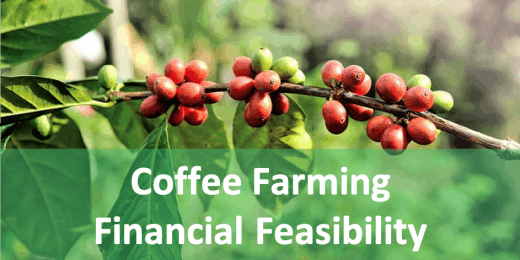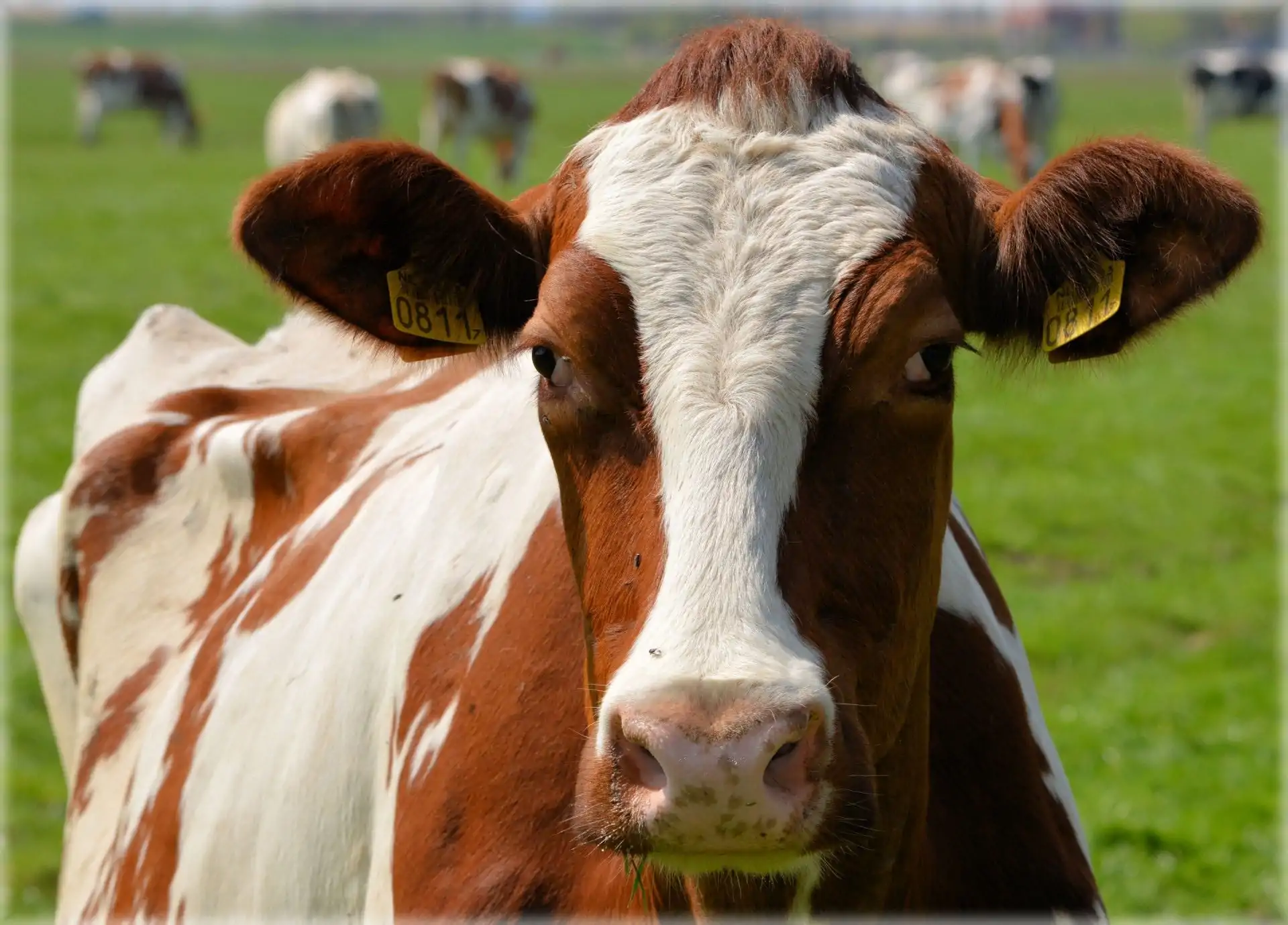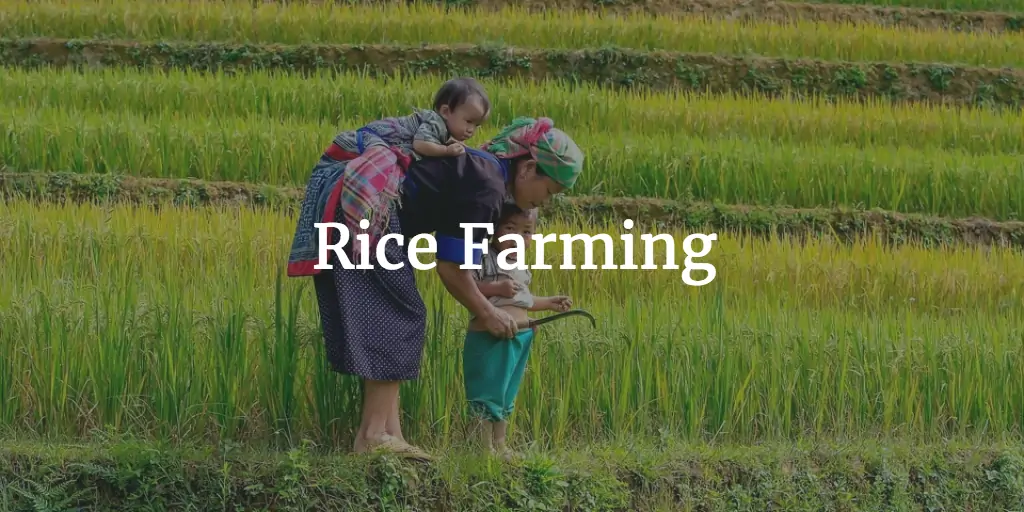How to Prepare a Financial Feasibility Study for Coffee Farming?
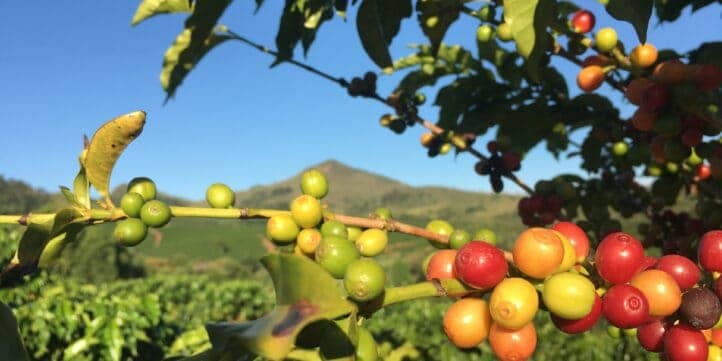
1. Introduction to Coffee Farming
This article will look at the coffee industry and the potential of investing in coffee farming. If you like to get this article as an eBook, kindly download it here.
Article as eBook – Free Download
The first part will explore world coffee bean production and identify the coffee producing countries with their respective production volumes, harvested areas, and harvest yield per hectare.
We will also discuss coffee bean farming in Brazil, Vietnam, Colombia, Indonesia, Ethiopia, Honduras, India, Peru, Uganda, Guatemala, Costa Rica, Mexico, Philippines, Malaysia, China, Kenya, and other producing countries.
The four varieties of coffee with their respective characteristics are presented. It will help the readers identify which coffee is more suitable to their location and the advantages and disadvantages of these coffee varieties.
It is also interesting to know the coffee prices worldwide and which coffee producers command higher prices than other producing countries. Available data presented are the two main varieties: Arabica and Robusta.
We will discuss the activities involved in coffee bean farming in detail, from finding suitable areas until the coffee beans are ready for selling. A comprehensive review of how revenues are computed and the direct costs involved in coffee bean farming will be presented. It will help the farm owners evaluate their proposed project before investing. The financial feasibility chapter will help us go through the financial analysis, identify the factors affecting profitability, and ensure that costs are kept in check. Sources of financing are also discussed, which shows the options for the coffee farmers in acquiring funding.
After reading this book, you will learn about the current coffee industry situation and how you can invest in coffee production. It can serve as a guide on what aspects to work through when starting a coffee farm.
2. World Coffee Beans Production
Coffee is the 2nd widely traded commodity in the world, next to oil. And it is expected to continue in the coming years. Because of people’s busy lives nowadays, caffeine sources such as coffee are gaining more popularity more than ever.
Coffee plants are primarily grown in countries with warm temperatures or countries located on “The Coffee Belt.” Most countries producing coffees are developing countries. Coffee is one of their major exported products, especially for the major producing countries.
The top coffee farming countries are Brazil, Vietnam, Colombia, Indonesia, Ethiopia, Honduras, India, Peru, Uganda, and Guatemala.
1.1 Coffee Producing Countries
World coffee production in 2019 reached 10,155,576 tons with an average of 9,738,619 tons for 2015-2019. The top producers are Brazil, Vietnam, Colombia, Indonesia, and Ethiopia. Brazil and Colombia are known as the primary producers of Arabica coffee, while Vietnam and Indonesia focused on producing Robusta. Arabica is the most produced variety, followed by Robusta.
Table 1 Top 10 Coffee Producing Countries (2015-2019), Tons
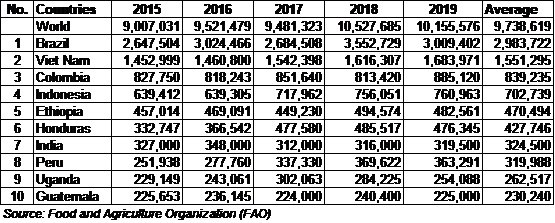
Coffee bean farming in Brazil produces 30.6% of the world production, followed by Vietnam (15.9%), Colombia (8.6%), Indonesia 7.2%, Ethiopia (4.8%), Honduras (4.4%), India 3.3%, Uganda 2.7%, and Guatemala 2.4%. The top 10 producing countries constitute 83.3% of the world’s production, while the rest of the producing countries shares the remaining 16.7%.
Figure 1 Top Coffee Producing Countries Percentage Share, Average
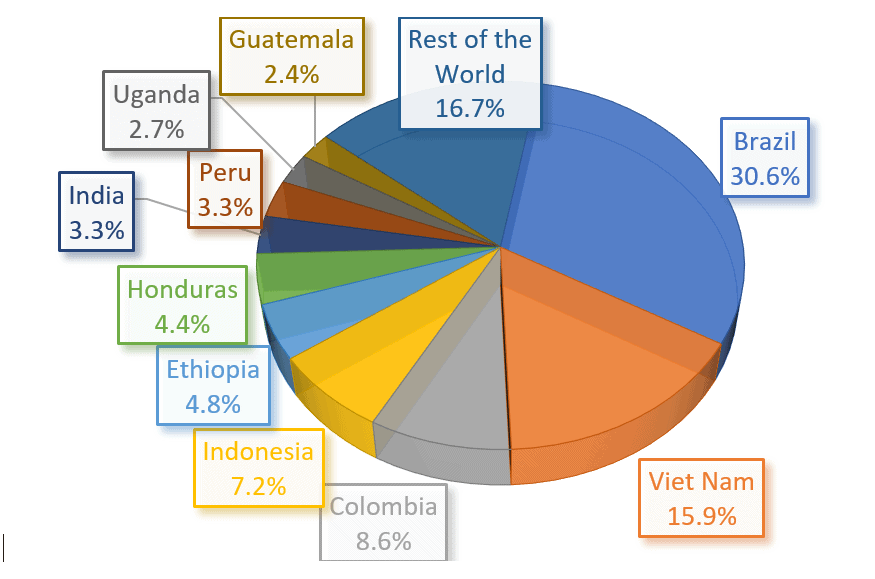
Source: Food and Agriculture Organization (FAO)
The map below shows the world coffee producing countries from the significant producers to minor coffee producers.
Map 1 World Coffee Producing Countries (1000 Tons)
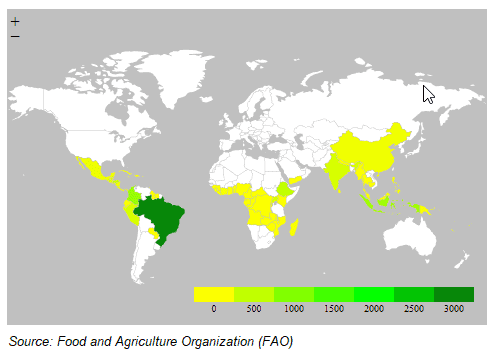
1.2 Coffee Farming Harvested Areas
In terms of harvested areas, coffee farming in Brazil also has the largest harvested areas of 1,896,821 average hectares. Other largest coffee bean farming areas are Indonesia, Colombia, Côte d’Ivoire, Ethiopia, Mexico, Vietnam, Uganda, India, and Peru. These countries with the most significant areas do not necessarily mean the top producers since countries like Côte d’Ivoire and Mexico are not among the top 10 producing countries. Their average yields are lower compared to other producing countries.
Table 2 Top 10 Coffee Producing Countries (2015-2019), Tons
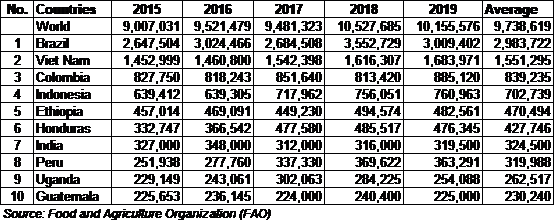
The top 10 countries with the most extensive areas shared 73.3% of the total harvested areas, while other producing countries constitute the remaining 26.7% of the harvested areas.
Map 2 Top 10 Countries with Largest Harvested Areas Percentage Share, Average
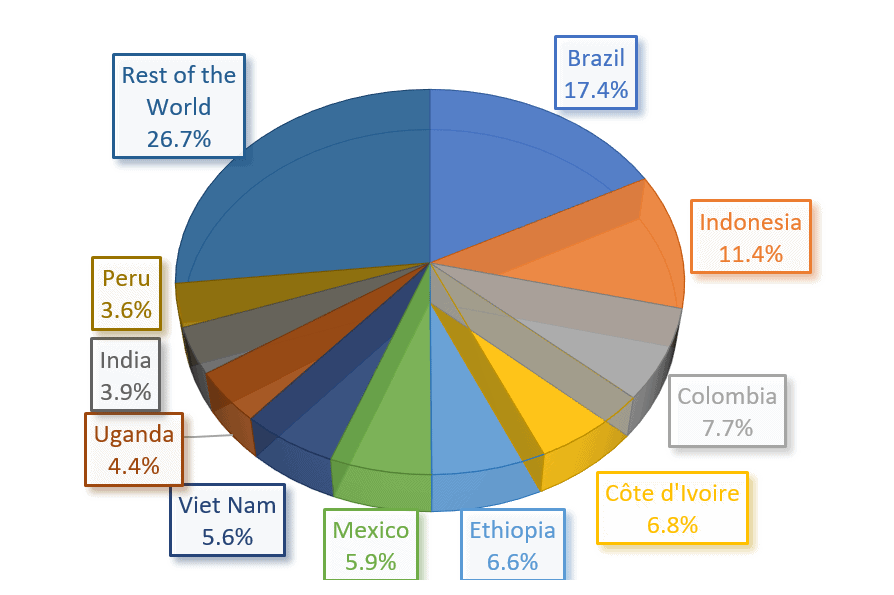
Source: Food and Agriculture Organization (FAO)
Shown in Map 3 is the world total coffee harvest area average (2015-2019).
Map 3 Coffee Harvested Areas (1000 Hectares)
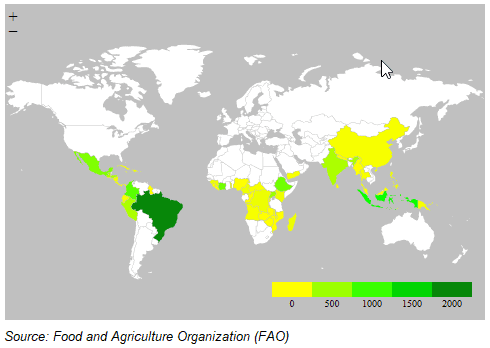
1.3 Coffee Farming Harvest Yield
Countries with the highest yields, Malaysia and China, are shifting their focus on specialty markets and producing high-quality coffee. They are still minor producing countries but already gaining recognition as coffee-producing countries. Other factors such as altitude, soil components, climate, care, and maintenance contribute to the yield per hectare.
Table 3 Top 10 Countries with Highest Yield (2015-2019), Kilograms/Hectare
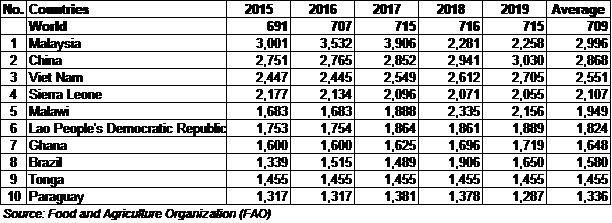
Figure 2 Top 10 Countries with Highest Yield, Kilograms/Hectare (Average)
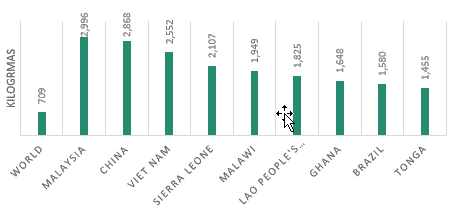
Source: Food and Agriculture Organization (FAO)
The world map below is the yield per hectare in a kilogram for the coffee-producing countries.
Map 4 Coffee Yield per Country (Kilograms)
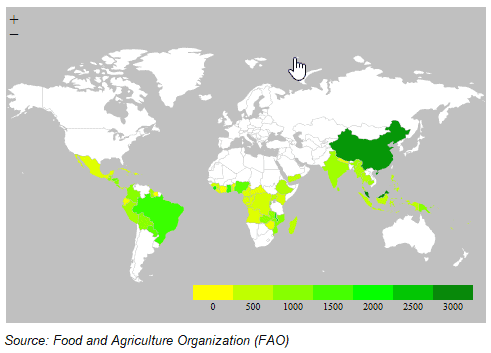
1. Four Different Coffee Varieties
There are four different coffee varieties produce in coffee bean farming, which are the Arabica, Robusta, Liberica, and Excelsa. These coffee varieties have distinct characteristics and features that attract coffee lovers.
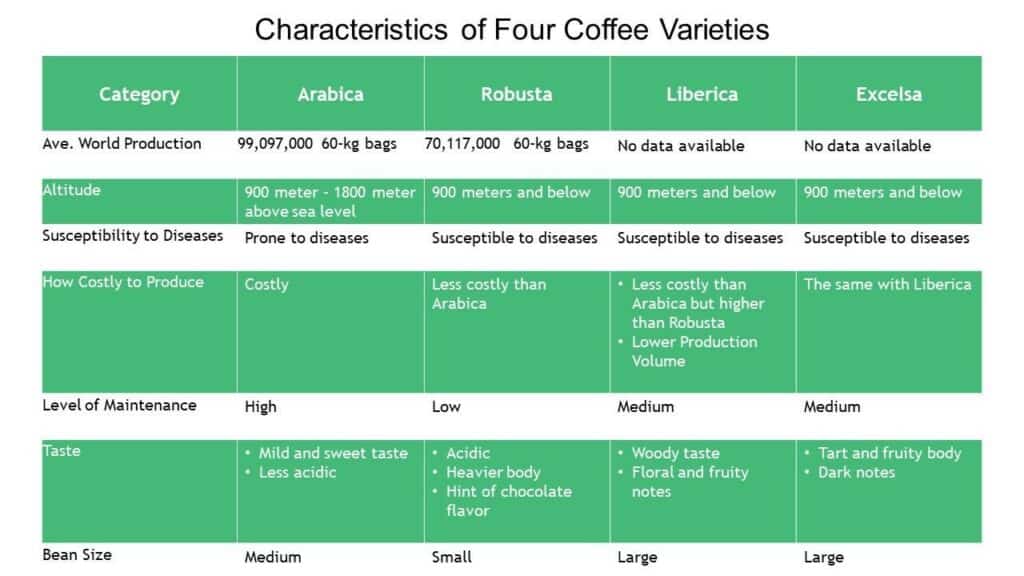
1.1 Arabica
Arabica is the most widely produced and marketed coffee variety in the world. It has a milder and sweeter taste and less acidic than other varieties. Arabica grows on highly elevated areas with regular rainfall and enough shade. Coffee, in general, needs a lot of shade to grow and bear fruit. Arabica is a delicate variety, which needs enough care since it is prone to diseases. Arabica is used for premium and specialty stores as this variety commands a high price and has excellent quality.
1.2 Robusta
Robusta is a rigid and robust variety that only needs little care to grow, as the name implies. Robusta has more caffeine that serves as a natural insect repellent to repel insects naturally. It is the second most grown coffee across the globe.
Robusta is grown at a lower altitude and warmer weather. It is more acidic and has a heavier body. However, high-quality Robusta is less acidic, smooth texture, and a hint of chocolate flavor.
1.3 Liberica
Liberica is not as widely produced as Arabica and Robusta. But this variety has a considerable contribution to coffee history. When coffee rust hit coffee farming in Brazil and other coffee-producing countries, coffee farmers in the Philippines started growing Liberica during that time, which served it well for its economy. Coffee farming in the Philippines grew and became one of the major suppliers. But after quite some time, the Philippines also caught up with the coffee rust that lower its coffee production. Coffee farming in the Philippines doesn’t recover since then.
Liberica grows taller than Robusta and has more giant beans. It has a more pungent taste which many describe as a woody taste. Liberica has a unique aroma, a full-body, smoky taste, and floral and fruity notes.
1.4 Excelsa
Excelsa was recently classified as a member of the Liberica family. It grows the same size as Liberica and grows in the same condition and climate. However, its characteristics are quite different from Liberica without a hint that Excelsa came from the same Liberica coffee family. Excelsa possesses a tart and fruity body and dark notes.
Excelsa is grown in small production in Southeast Asia. The variety is mainly used as a blend to give an extra boost and flavor. Others may not like its strong taste, but it is an excellent choice to come by for some that appreciate its unique flavor and aroma.
2. Production Volume per Coffee Variety
Available data for production is only for Arabica and Robusta, as they are the two most produced and marketed coffee beans. Arabicas are further classified into Colombian Milds, Other Milds, and Brazilian Naturals. As Brazil is the primary producer of Arabica coffee, Brazilian naturals are the widely produced Arabica coffee.
For 2017, Arabica production was 95,682 tons 60-kg bags then increases to 105,325 tons 60-kg bags. On the other hand, Robustas recorded production for 2017 was 68,011 tons 60-kg bags, as shown in the table below.
Table 4 Production Volume per Coffee Variety (In 1000 60-kg bags)

Arabica shares the highest production percentage with 58.6%, while Robusta shares the remaining 41.4%, as shown in Figure 3.
Figure 3 Coffee Varieties Percentage Share
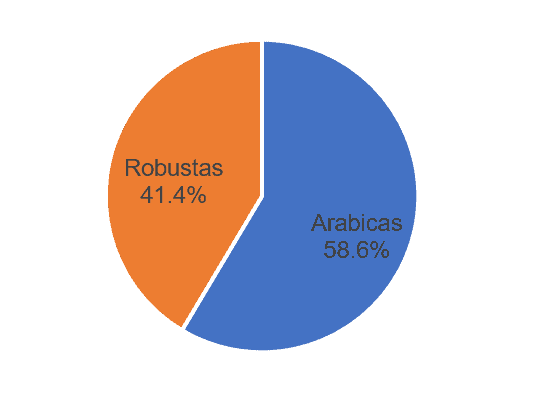
3. Coffee Bean Prices
Coffee prices depend on demand-supply and quality of coffee beans. Coffee is a commodity in which prices are affected by market changes and speculations, and geopolitical issues. Some coffee farming countries which command higher prices for their coffee beans are Colombia for Colombian Milds, Bolivia, Cuba, Dominican Republic, Costa Rica, and Guatemala for Other Milds. For Brazilian Naturals, Thailand, Angola, Brazil, and Ethiopia have garnered the highest paid prices. Thailand, Angola, India, Brazil, and Gabon have the higher-paid prices for Robusta.
Current prices are affected by the COVID-19 situations where there is excess supply due to the decrease in demand as many cafés and restaurants are still closed or have limited opening hours. The consumption is also shifting from Arabica to Robusta as consumers now drink more instant coffees at home. Robusta is the variety produced into soluble and instant coffees.
It is expected that consumption will increase again once restriction eases and coffee shops and restaurants start to open again.
Table 5 Highest Prices Paid to Coffee Growers (in US$/lb)
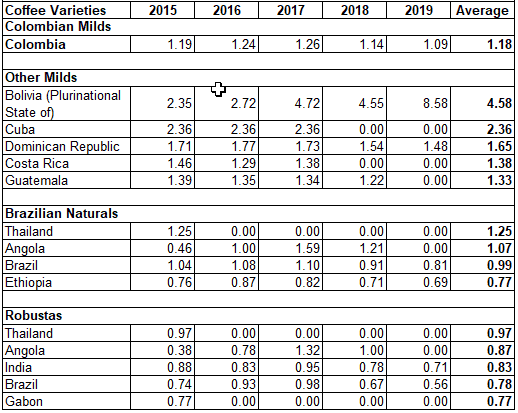
Source: International Coffee Organization (ICO)
4. Coffee Bean Farming Activities
Coffee farming is widely done in the so-called Coffee Belt in the countries like Brazil, Colombia, Costa Rica, Mexico, Guatemala, Vietnam, Indonesia, the Philippines, Kenya, Ethiopia, and other countries with temperate climates. Coffee is best planted in rich soil, with ample rain, higher altitude (for Arabica), and under shade.
It approximately takes two years from planting to flowering, then another year before you reap the harvest. Let’s evaluate the process and activities of growing coffee.
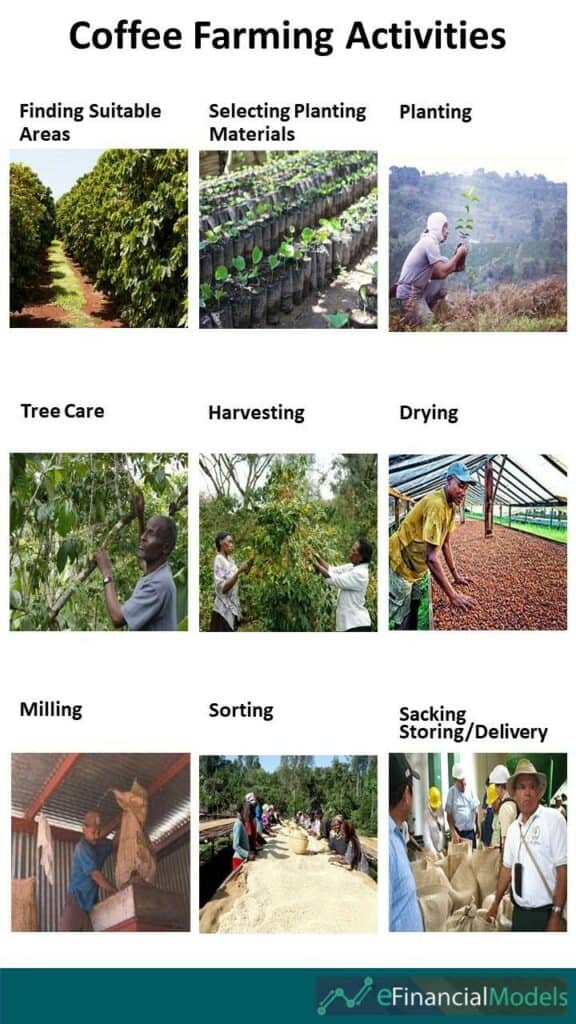
4.1 Finding Suitable Areas
Coffee plants require loamy soil of up to 150 cm depth for good rooting, water, and nutrient absorption. Soil acidity tolerance is as low as pH 4.5. A flat to gentle slope is suitable for coffee farming.
Robusta, Excelsa, and Liberica grow best up to 900 above sea level, while Arabica needs a higher elevation with optimum growth at 900 m to 1,800 m above sea level.
Climatic requirements vary according to coffee species. Robusta, Excelsa, and Liberica grow best within 15-30°C temperature with 1000-2000 mm of annual precipitation. On the other hand, Arabica grows in areas with 15-25°C and 1500-2000 mm annual precipitation
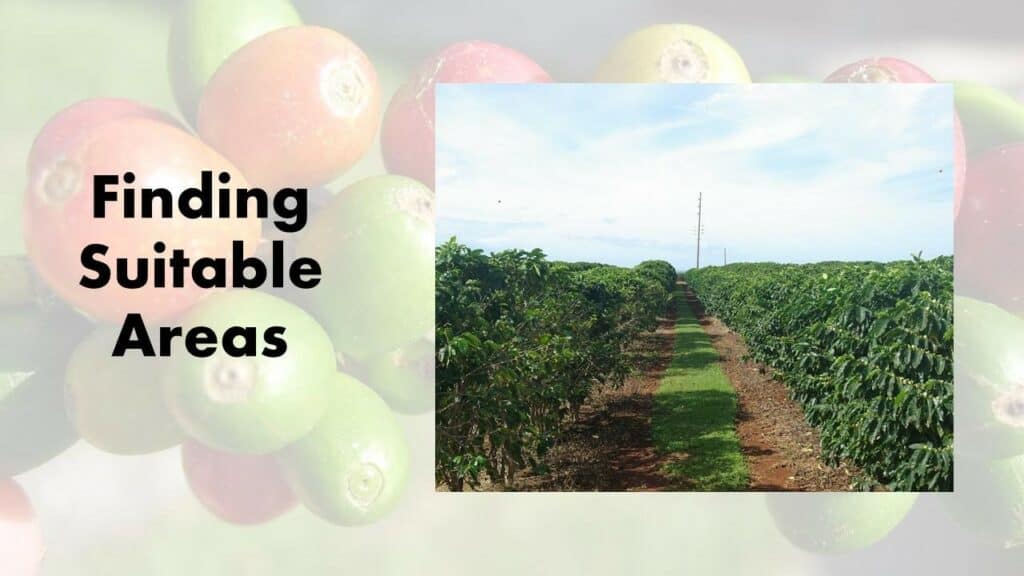
4.2 Selecting Quality Planting Materials
Coffee bean farming’s success starts from selecting excellent planting materials to have maximum productivity. You can have your nursery produce planting materials or source out from a nursery.
For producing your planting materials, ensure that you get the beans from the most productive trees with ripe red berries. Suitable age coffee seedlings have 6-8 leaves, which approximately takes one year from sowing.
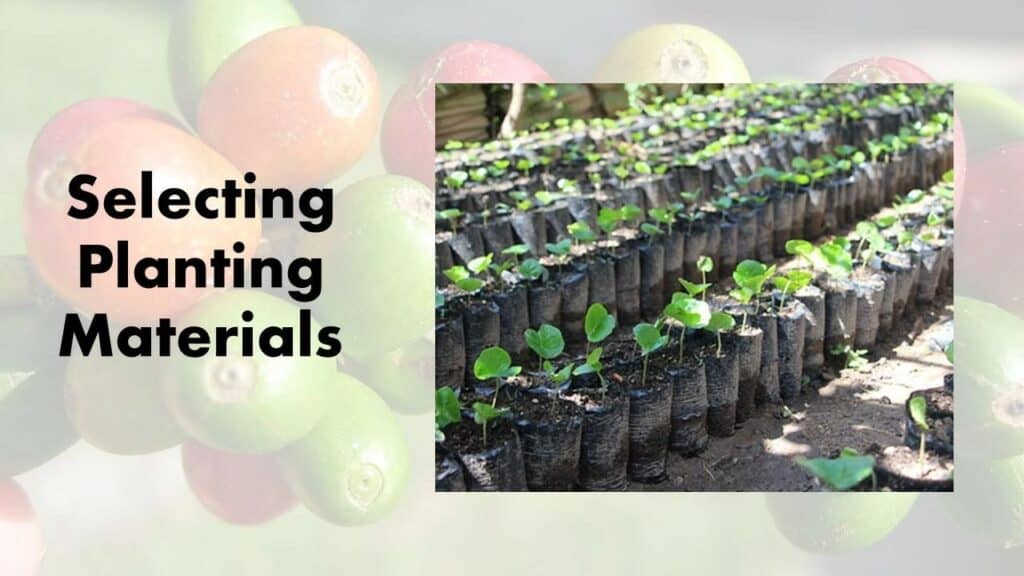
4.3 Planting
Make sure to weed the areas properly. It is advantageous to dig a hole for planting to make it easier for transplanting and good root development of seedlings. Planting is best during the wet season to quickly acclimatize the coffee seedling to its new location.
According to Philippine Coffee Board, the layout of the field should be prepared following the recommended planting distances:
For Arabica – 2m x 2m (monocropping); 2m x 3m or 2m by 5m if vegetables will be intercropped
For Robusta – 2m x 3m (monocropping) or 3m x 3m with intercrops
For Liberica & Excelsa – 3m x 4m (monocropping) or 4m x 4m with intercrops
Seedlings should be watered adequately in the bags, then remove the bags before planting. Seedlings are planted upright and not at an angle. Firmly press the soil for the seedling to easily create roots to the new soil. Depending on the soil components, you can add fertilizer as a basal to the seedling. The soil test result will show what fertilizers you need.
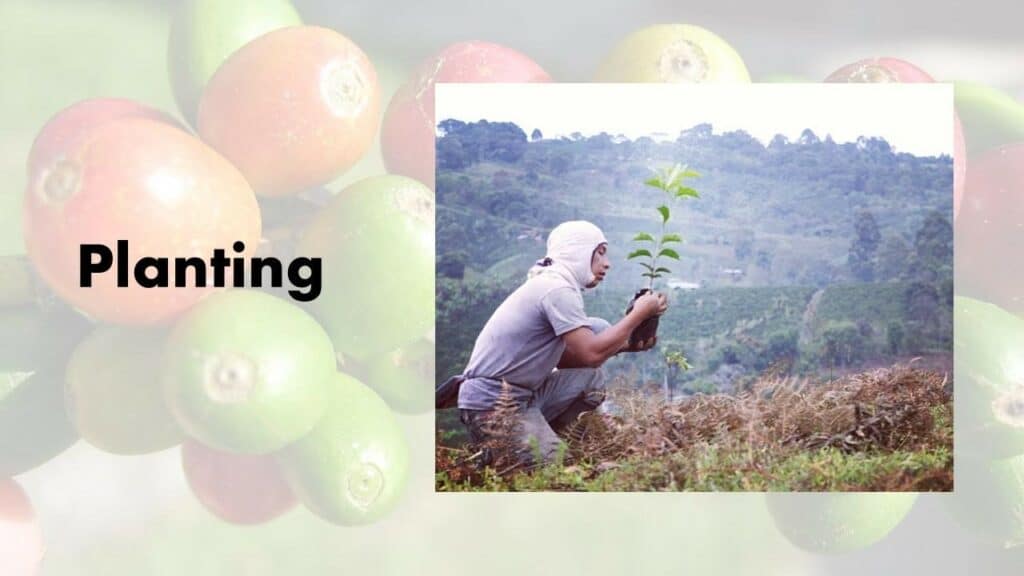
4.4 Tree Care/Maintenance
During its growing state, coffee farming’s main activities are weeding, pruning, fertilizer application, and pesticide/fungicide application as needed. For the first year, there is no need for pruning since the coffee plant is still young. Weeding and fertilizer application will commence every three months from planting. Others also do round weed to optimize absorption of nutrients with the surrounding area of the coffee plant. Regular monitoring is needed to detect early-stage pests.
Coffee berry borer, coffee leaf miner, and mealybugs are some of the usual pests. Common coffee plant diseases are leaf rust, coffee wilt and, pink disease. Coffee plants must be well maintained to minimize the proliferation of pests and diseases. Especially for more giant farms, hiring a technical expert to ensure proper care and management are provided to the coffee trees.
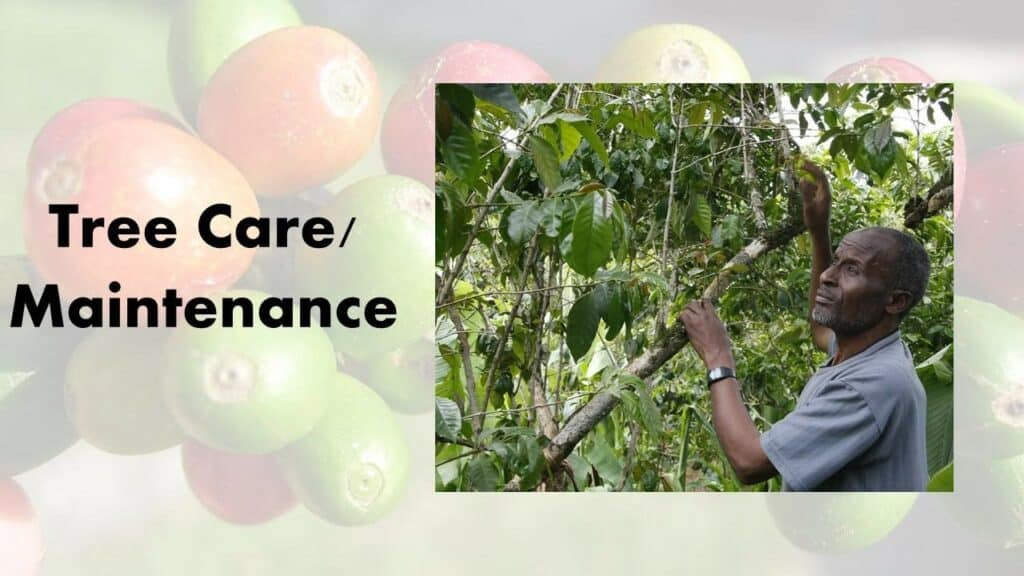
4.5 Harvesting
Coffee berries are green when unripe, then turn to yellow and red once ripe. It is excellent to harvest when coffee berries are optimum ripeness to achieve maximum weight. Harvesting will either be done by hand or machine. However, machine harvesting can only be used for flat surfaces. Especially for Arabica, coffee bean farming is in high elevation and most challenging to access. For large farms, hiring many workers must harvest the berries on time and minimize losses due to falling coffee berries.
There are two methods of coffee harvesting: Strip Picked and Selectively Picked
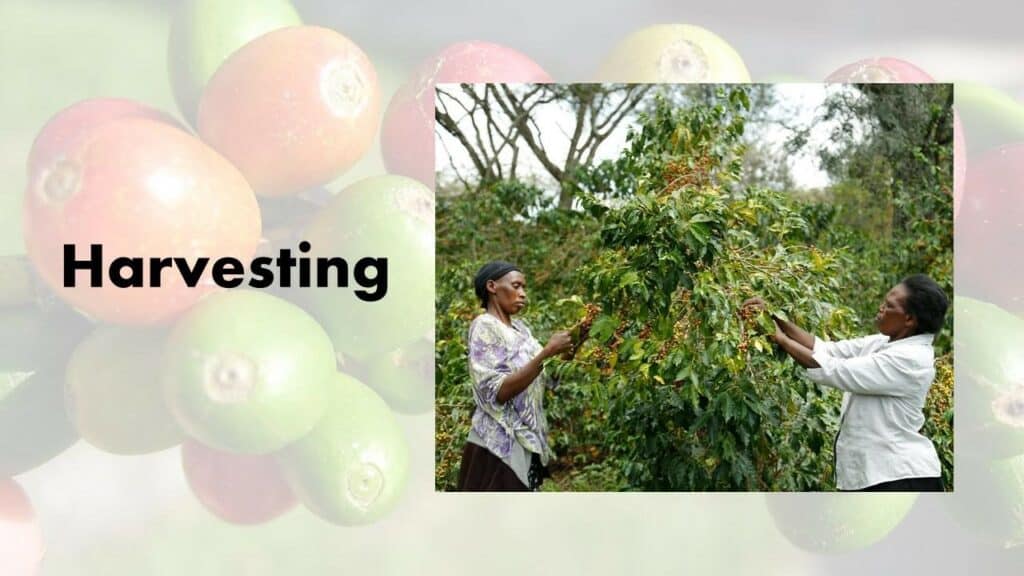
4.5.1 Strip Picked
For strip-picked harvesting, coffees are stripped off from the branches, including ripe and unripe coffee berries. Usually, unripe berries near the ripe ones are already mature.
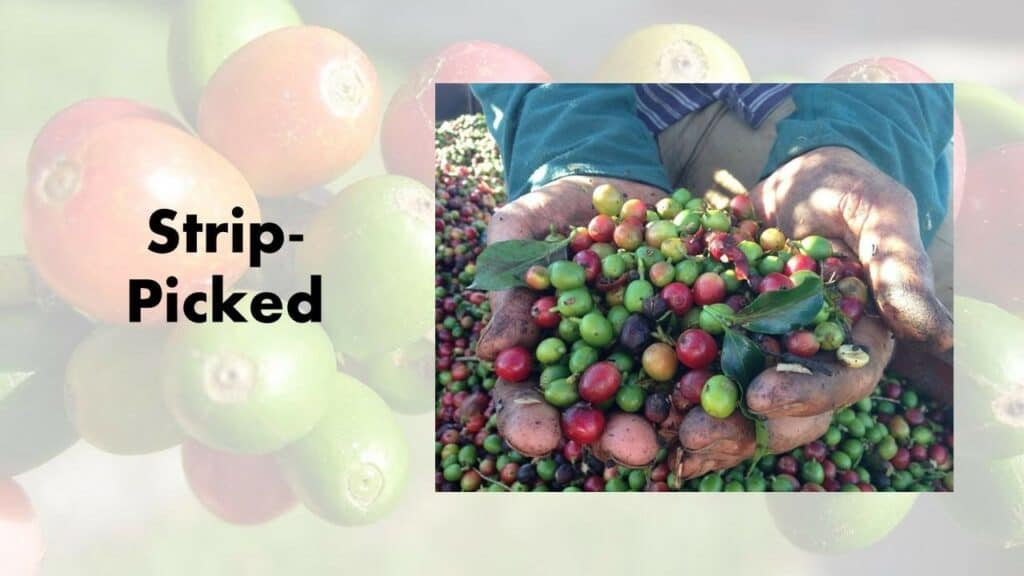
4.5.2 Selectively Picked
Selective picking is mainly done for Arabica coffee since this process is more labor-intensive and costly. Arabica is sold at a premium. Harvesting the beans through selective picking could the best beans for processing. Ripe beans are at maximum weight and excellent quality.
The harvesters are either paid in cash for the quantity of harvest or paid through coffee beans. Harvests per day per person are between 120 – 180 kilograms, with a recovery of 20% after drying.
The practice of paying through coffee beans is practiced for coffee farming in the Philippines. The harvesters will then process their shares then sold them to coffee traders. They can earn more by doing this compared to if they are paid in cash.
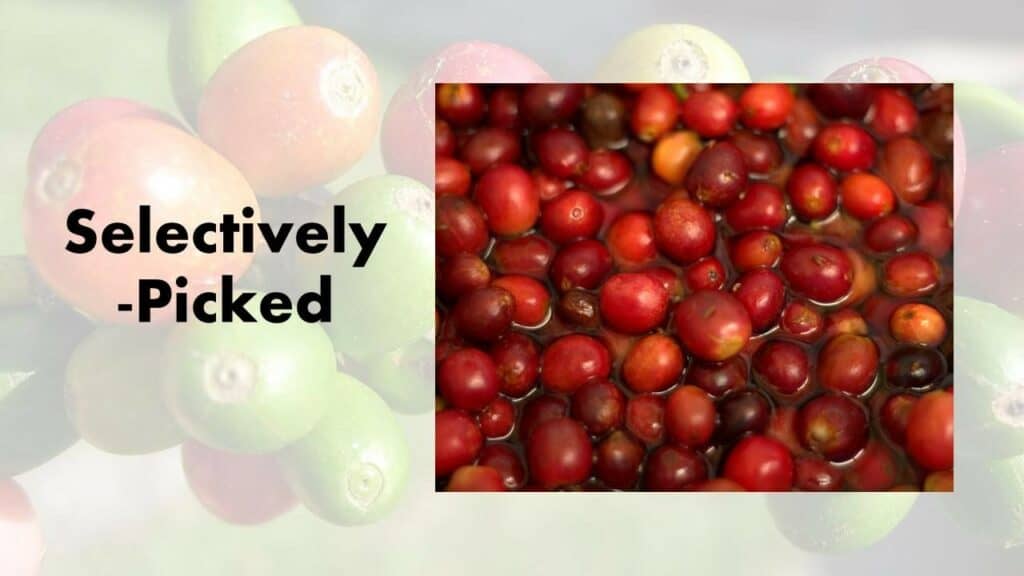
4.6 Drying
Processing can either be done through a dry process or a wet process. The dry process is the conventional coffee processing method in which fresh-picked coffee beans are sun-dried on concrete pavements or a drying net. This method is mainly used in areas where there is there limited supply and no machinery available. Coffee berries are raked and turned several times a day. Depending on the sun heat quality, drying will take 7-14 days to achieve the 11% moisture content.
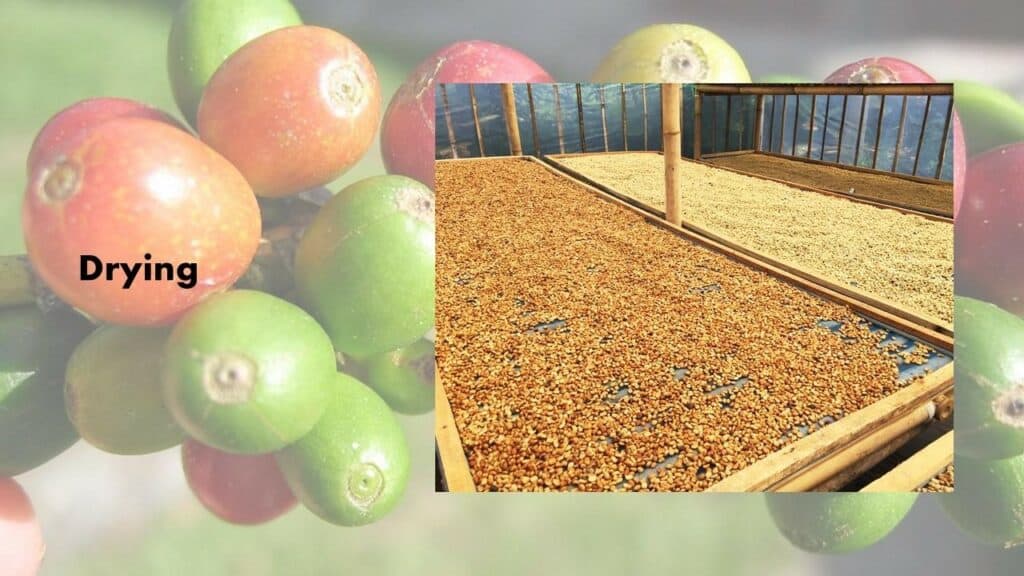
The wet process removes coffee skin from the parchment by using a de-pulping machine. De-pulped coffee beans then went through a water channel where the lightweight coffee beans float and separated from the rest. Those beans which float have lower-quality beans. There are rotating drums that separate the beans by size.
After beans are separated based on quality and sizes, they will now be put into a large, water-filled fermentation tank. Climate, altitude, and bean condition will affect how much longer they will stay in the fermentation tank but approximately take 24 – 48 hours. The fermentation removes the slick layer of mucilage still attached to the parchment. Natural occurring enzymes will dissolve this slick layer. After fermentation, beans are washed once again and then set for drying, taking 3-5 days.
4.7 Post-Processing
4.7.1 Milling
After drying, coffee beans are now ready for milling. For dry-processed coffee, milling will remove the entire dried husk, including the outer skin, pulp, and hull. Only the parchment or the hull will be removed for wet-processed coffee.
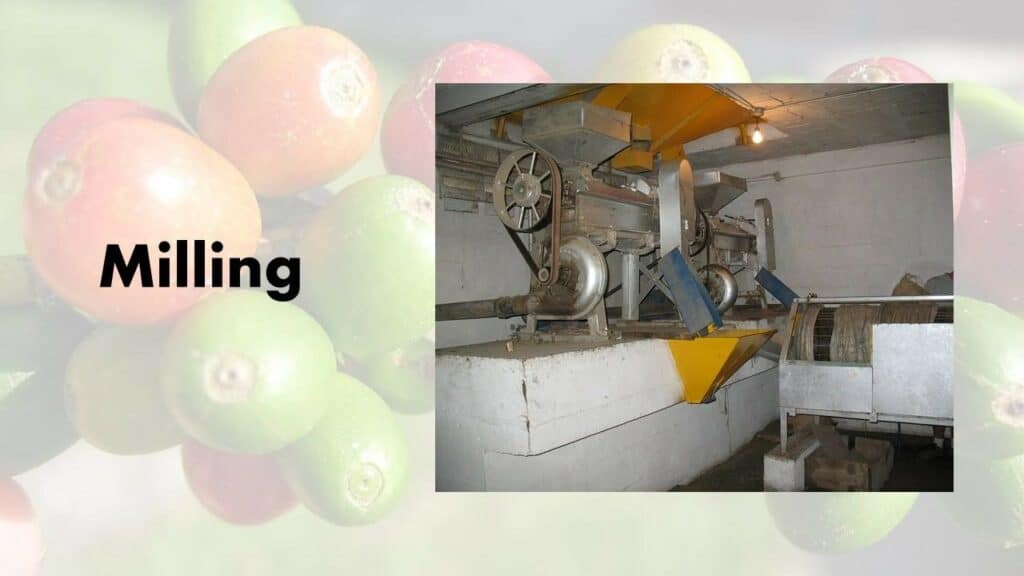
4.7.2 Polishing
Polishing is performed to produce more quality coffee beans, especially for the premium market. Polishing will remove the silver skin and be considered superior compared to unpolished beans.
4.7.3 Sorting, Sacking, Storing/Delivery
Grading and sorting are done based on quality and sizes. Bean sizes are measured on a scale of 10 to 20, which is the diameter out of 1/64 of an inch. A number 15 beans mean 15/64 of an inch. Defective beans are removed with unacceptable color or size, insect-damaged, not hulled, or over-fermented. Coffee beans are then sacked and stored or delivered.
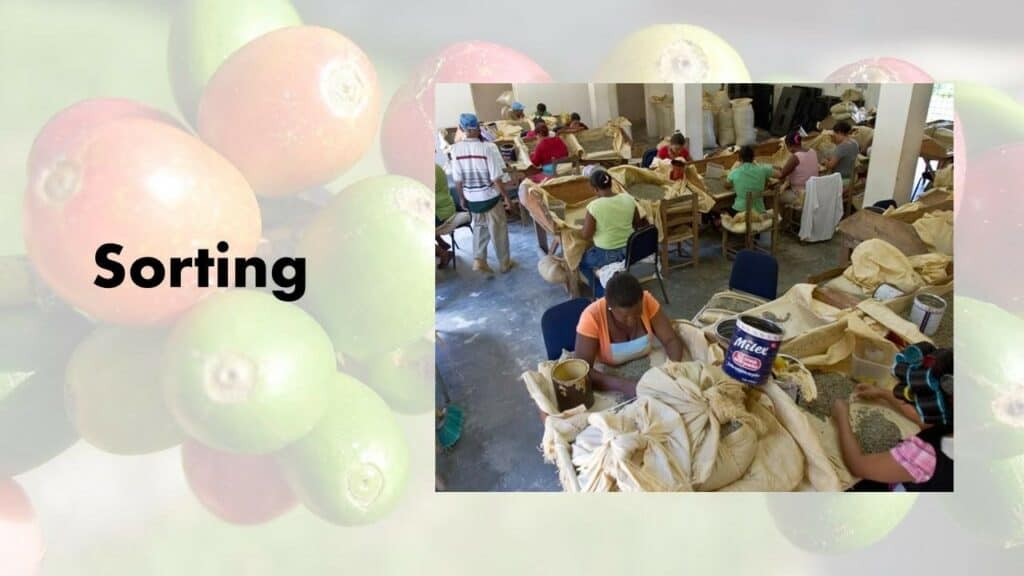
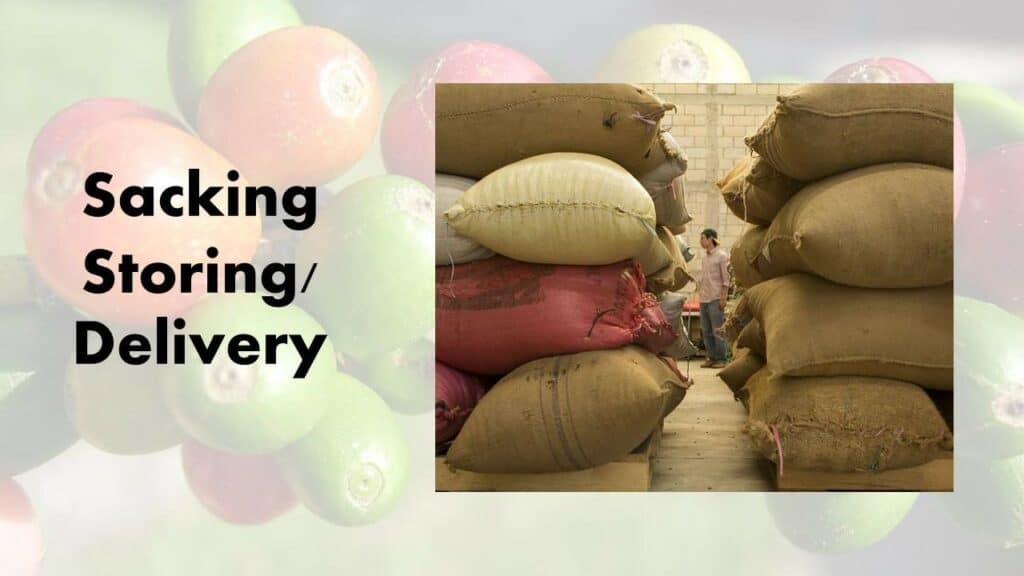
5. Who Owns Coffee Farms?
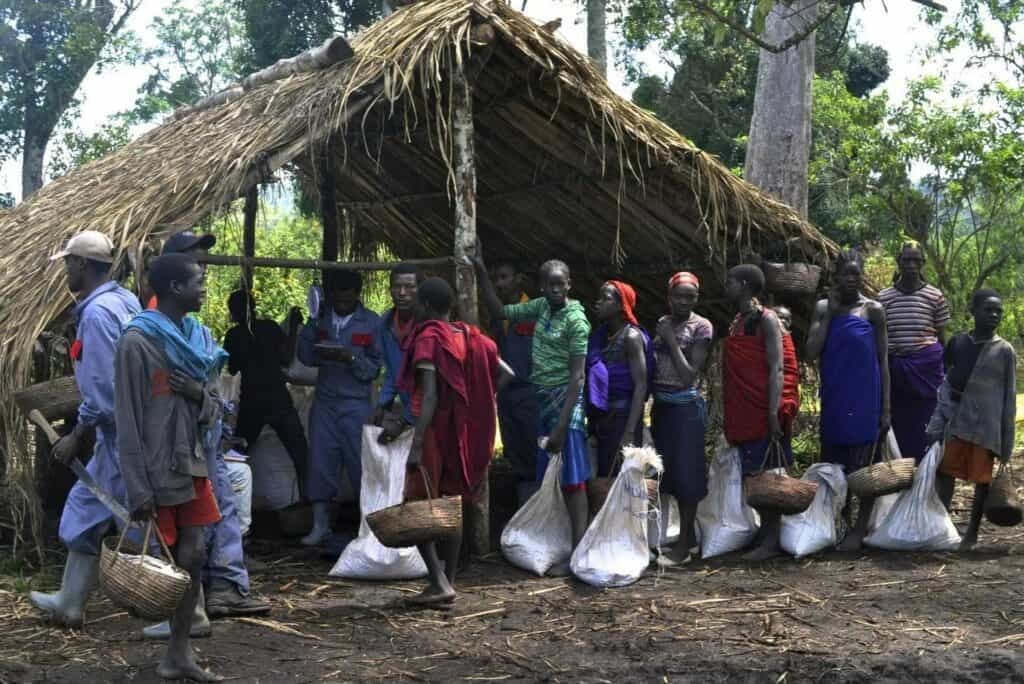
80% of the world’s coffee bean production is produced by the 25 million small coffee farmers or family-owned coffee farms. About 125 million people depend their livelihoods on coffee.
Due to fluctuations in coffee prices, small coffee farmers with farm areas of 2-3 hectares have not enough to sustain their family needs and allocate farm maintenance for more productive farms.
The respective governments of the producing countries should improve the technology and earning capacity of smallholder coffee farmers.
However, large plantations can be profitable since farm owners have enough resources to finance maintenance and wages for farmworkers and employees. Maintenance is not labor-intensive. It is during harvest season where many workers are needed to cope up with picking on ripe berries.
Financial Model Templates related to the Agriculture Industry
6. Coffee Farming Financial Feasibility
Investing in coffee plantations needs ample resources. Thorough planning and preparations and enough know-how are necessary before investing. Assessing financial feasibility before investing in coffee bean farming is a must to do. eFinancialModels both have Comprehensive and Simple Coffee Farm Financial Model Templates in aiding you in assessing the viability of your proposed coffee plantation.
Let’s evaluate in detail what is needed to assess the coffee farming financial feasibility.
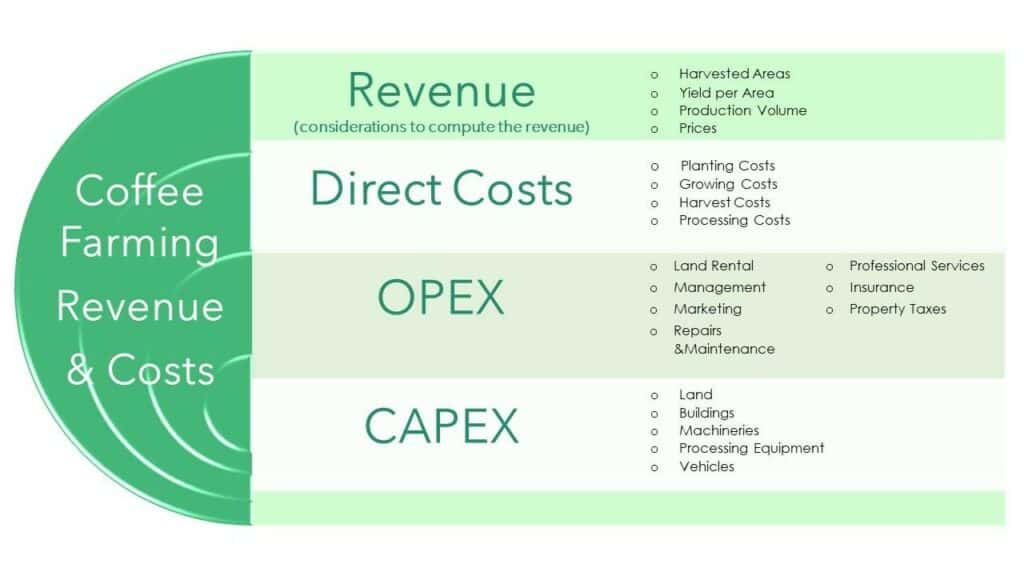
6.1 Revenues
Factors affecting revenues are the total harvested areas, yield per hectare, production volume, coffee quality, and prices. We will discuss these factors individually below to give us ideas on how to compute your coffee farm revenues.
6.1.1 Harvested Areas
Coffee bean farming takes at least three years, from planting to harvesting. Typically, the coffee harvest is once a year, except for coffee farming in Kenya and Colombia, which have two harvests in a year: the main harvest and fly harvest. The fly harvest has a lesser harvest compared to the main harvest.
Shown in the table below is the number of hectares for harvest per area for your coffee plantation.

6.1.2 Coffee Beans Production Volumes
Harvested areas are multiplied by the harvest yield to derive the harvest volume. The base yield’s annual change is the deviation from the projected average yield of 1,500 kilograms per hectare.
The production volumes are distributed based on the percentages per coffee class into Class A and Class B.

From harvest, it will approximately take 2-3 weeks for processing (drying, milling, sorting) before you can sell the coffee beans.
Production volumes per class are multiplied by their respective selling prices to compute the total revenues. Selling prices will vary on the coffee beans quality and countries where you from.


6.2 Direct Costs
Costs are incurred starting from planting, growing, harvesting, and processing. The total costs will depend on the volume produced and land under management. These costs will go up if you will plant more and produce more volume. The figure below shows presents the coffee farming direct costs.
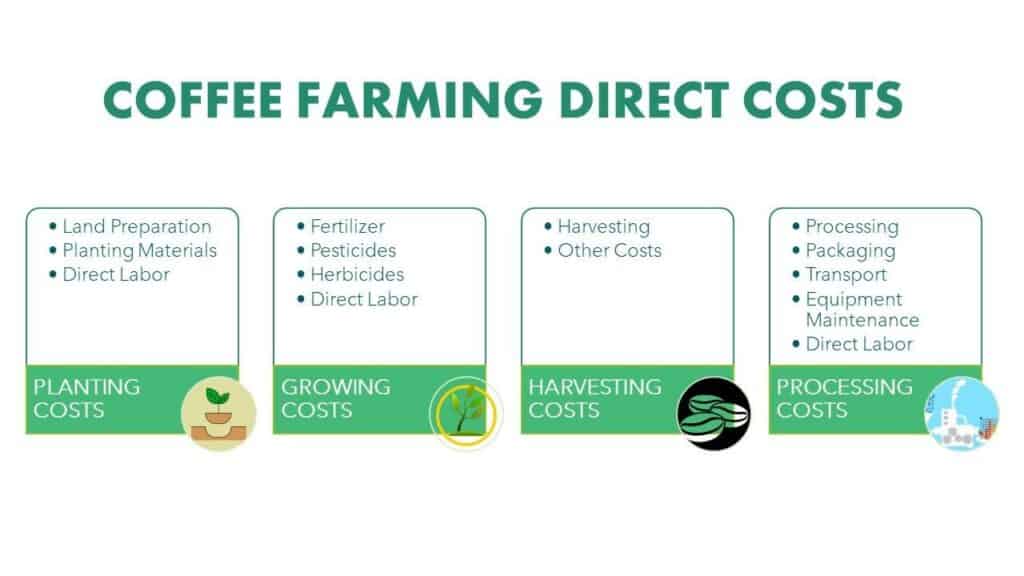
Since cash inflows only happen once a year, the owner must set aside after harvest for maintenance/tree care to ensure that the farm is well-maintained to produce an abundant harvest.

6.2.1 Planting Costs
Planting costs include land preparation, planting materials, planting workers.
6.2.1.1 Land Preparation
Coffee farms should be free from weeds and ready for planting. You can either hire laborers to manually clear and weed the area or hire few people to spray herbicide. However, constant spraying of herbicide will take a toll on soil fertility and the environment. If it is rainforest-like as coffee farming in Brazil, you might need to cut large trees that give too much shading and cause a delay in coffee tree growth. However, coffee trees need ample shading, so make sure there are still some trees left. River tamarind (ipil-ipil) is a good shading for coffee trees. Coffee plants can also be intercropped with coconut trees. Before planting, you need to do staking to make sure that the distance between trees is followed.
6.2.1.2 Planting Materials
Monocropping can plant up to 1,100 trees in a hectare. Also, have 10% excess planting materials for replanting as a back-up if some trees will die.
6.2.1.3 Direct Labor for Planting
3-4 workers are needed for planting per hectare, especially for slope terrain areas. Flatland areas need few direct laborers.
6.2.2 Growing Costs
Hire few regular workers to look after the farm to ensure that proper care is given to the trees. Pests and diseases can be prevented from spreading if detected early.
Usually, weeding is done first to work around the farm efficiently. Pruning is performed to discard the other suckers that grow. Around 3-4 suckers are grown per tree. It will allow the coffee tree to be more productive and enough nutrients to support the plant. Pesticides and fungicides are applied when necessary. It is essential to allocate pesticides and fungicides since there are seasons that pests and diseases occur. Allocate costs though these are not quarterly activities for coffee farming.
6.2.3 Harvesting Costs
Harvesting costs incur high costs. You need to hire enough people for harvesting. It can be challenging to hire workers during harvest season since coffee harvests are the same per location. It is crucial to hire workers before the start of the season. Small coffee farms will hire few harvesters who will stay until the end of the harvest season. Depending on the arrangement, harvesters’ share can be cash or coffee berries.
For not-so-accessible farmlands, make arrangements that coffee berries be brought to the processing/drying areas.
6.2.4 Processing Costs
6.2.4.1 Drying
If a wet process is done, ensure that you have enough water to undergo the process. The coffee berries will go through water channels then fermentation before coffee berries undergo the drying process. Drying costs primarily include direct labor. For the dry process, laborers should rake and turn coffee berries several times a day to have balance dryness. Cover the coffee berries to keep them from rain and mist during the night.
6.2.4.2 Milling
Depending on the harvest volume, coffee farm owners can either build their coffee mill or pay for milling costs with the nearest coffee millers in the area. Polishing can incur additional costs.
6.2.4.3 Sorting
Sorting is laborious and time-consuming. Coffee beans with impurities, those with different colors, shapes, and not hulled, will be removed either by hand or machine.
6.3 Land
Farmland prices vary from country to country. Average farmland prices for coffee farming and other crops in Brazil were pegged at $2,530 per acre. Accessible farmlands in Colombia are priced at $3,000 – $5,000 per hectare, while more isolated farmlands are priced at $1,600 – $3,300 per hectare.
You can either lease or acquire land for coffee bean farming. Renting would mean smaller costs will be incurred, but the owner might not renew the lease once the contract ends. On the other hand, buying lands is a good investment as land value appreciates. However, it can be a significant investment on your part, and you might not want to invest a massive amount of money, especially when starting.
Survey the available farmlands in your area suitable for coffee bean farming and how many hectares you can buy or lease.

6.4 CAPEX
Aside from land, you need to invest in building and machinery, and equipment. The building can serve as a processing area, warehouse, office, and staff house. Equipment you will need for coffee farming is a de-pulping machine, dryers (concrete or light materials), coffee miller, and vehicles.

7. Coffee Bean Farming Financial Projections
This section will evaluate the three financial statements: income statement, balance sheet, and cash flow statement.
7.1 Income Statement
The income statement is a helpful financial tool to use to know your profit and net income. The EBITDA (Earnings Before Interest, Tax, Depreciation, Amortization) is a good measure of your business profitability, less direct costs, and operating expenses.
The income statement considers the depreciation, which means you will not account in full for your asset acquisition. However, always compare your cash flow as it reflects the availability of resources for day-to-day operation.
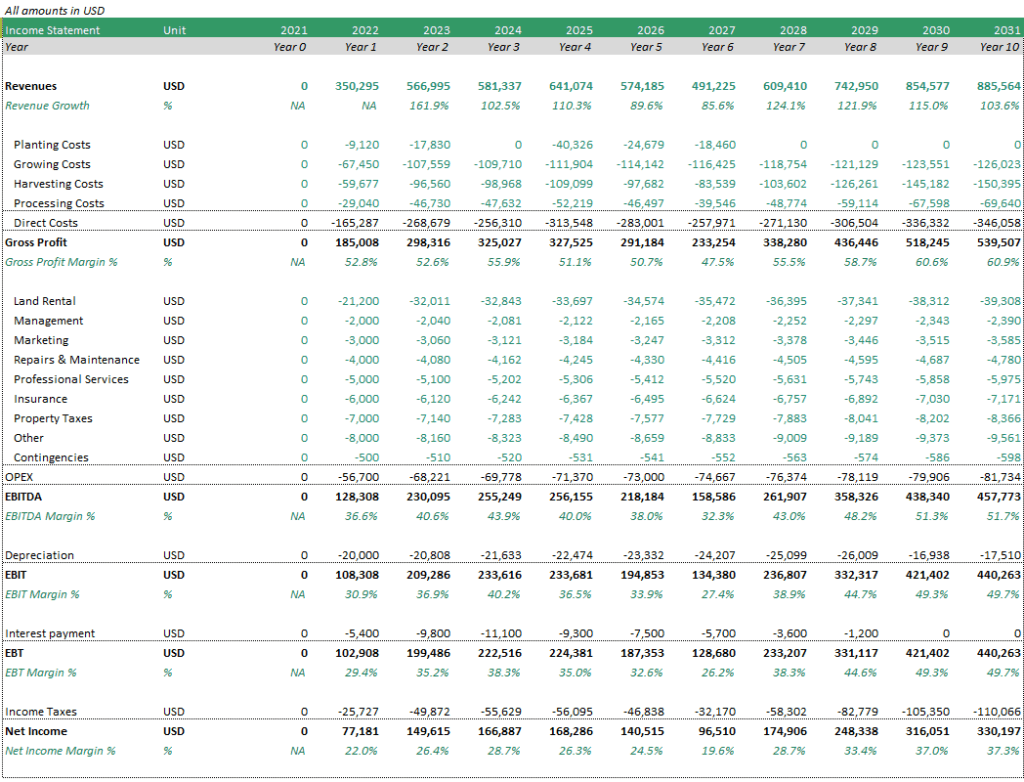
7.2 Cash Flow Projection
It is crucial to have monthly monitoring of cash flows to ensure that you won’t run out of cash during the growing stage and waiting time between harvest. There is only one harvest a year, but you need to pay for maintenance all-year-round. Have a monthly and yearly projection to determine when you will recover your investment and start to earn a profit.
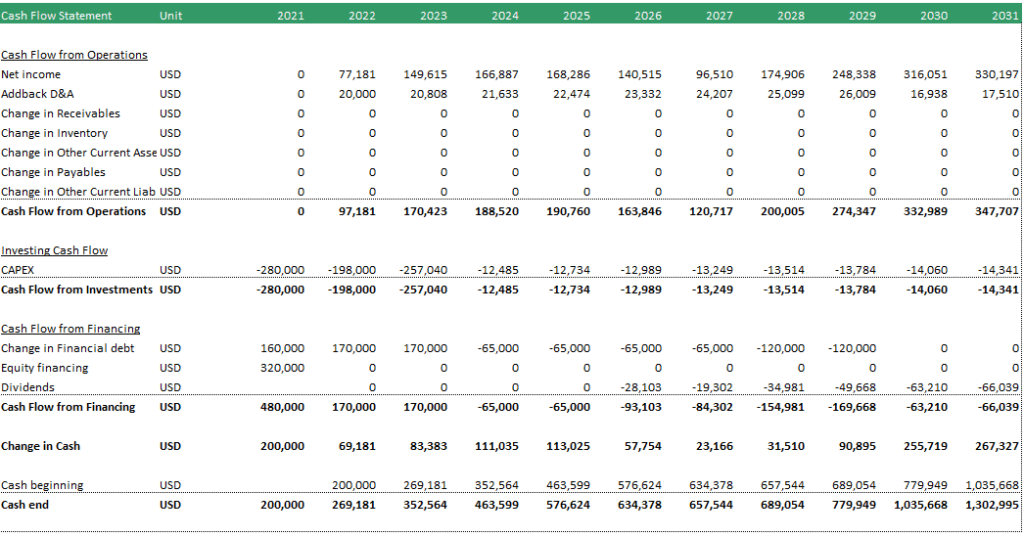
7.3 Balance Sheet
The balance sheet is composed of your Asset, Liability, and Equity Sections. Current assets include your cash, accounts receivable (if any), and inventory. If you sell to traders and the production volume is not in large volume, you will probably be paid in cash. If you are selling directly to main buyers, you may wait for a few days or weeks for payment processing.
Fixed assets include land, building, equipment, and vehicles. Liabilities include accounts payable for your suppliers (farm inputs, service providers), loan payables, taxes, and other financial obligations. Equity includes your investment, loans, and funding from investors.

8. Financial Analysis
This chapter presents the financial ratios and financial metrics to provide a more informative analysis regarding the proposed project.
8.1 Financial Ratios
Financial ratios are critical metrics to evaluate the figures presented in the financial statements. It makes more sense out of the income statement, cash flow, and balance and sees trends. The financial ratios we will discuss here are bank ratios, liquidity ratios, profitability ratios, efficiency ratios, and growth ratios.
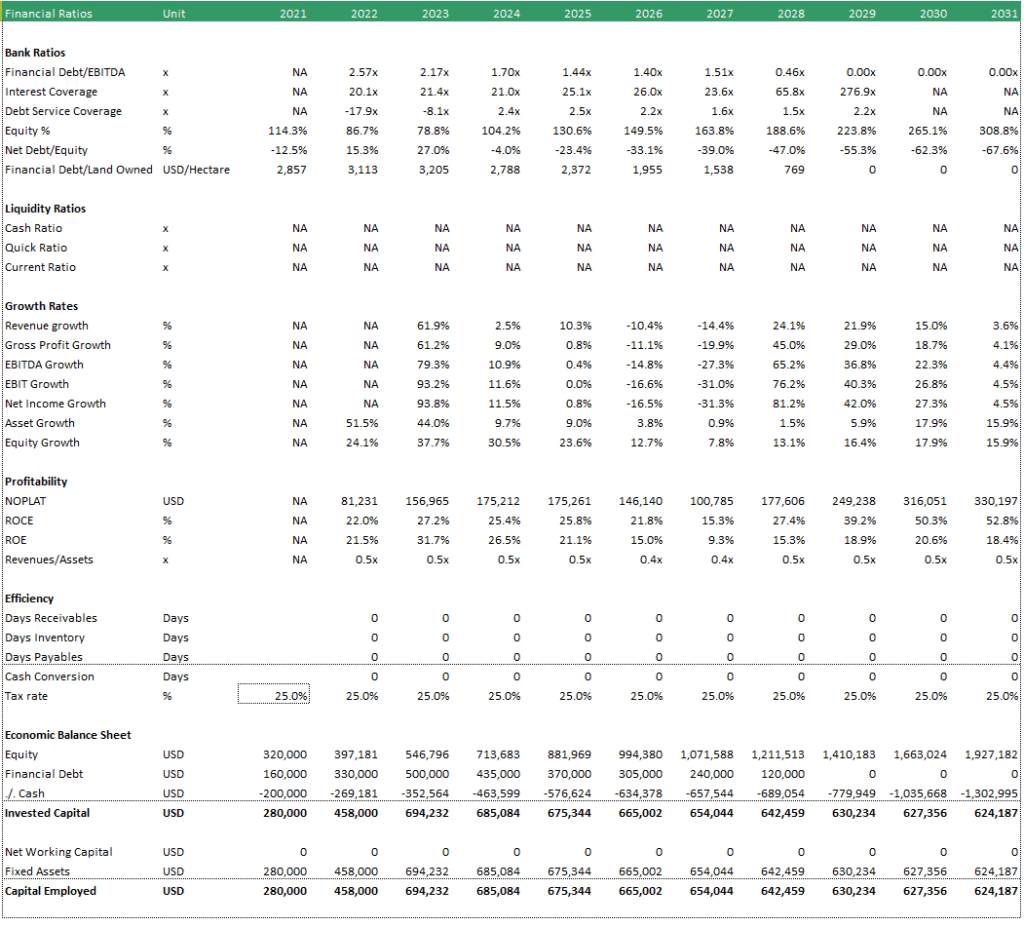
8.1.1 Bank Ratios
Bank ratios are used to determine the capacity of a coffee farm to pay its debt when due. Banks particularly scrutinize it to determine if your proposed venture is eligible for bank financing.
Banks’ ratios evaluate the capital structure, how heavily it is financed through debt or a mix of debt and equity.
Financial debt/EBITDA measures the percentage of financial debt out of EBITDA. A Financial Debt/EBITDA of 1.5x means that the business can quickly pay back its debt within 1.5 years. A ratio of >3x would make the bank doubts your capacity to pay.
Debt Service Coverage Ratio (DSCR) is calculated by taking the free cash flow to the firm (FCFF) then divided by the debt repayment + interest. A higher DSCR means the capacity of the business to pay its financial obligation.
8.1.2 Liquidity Ratios
Liquidity ratios measure the business’s capacity to meet current financial obligations without requiring additional capital. Some of the liquidity ratios are cash ratios, quick ratios, and current ratios.
Cash ratio, quick ratio, and current ratio are divided to current assets to determine if cash, quick assets (current assets-inventory), and current assets are at the threshold to pay for its current obligation.
8.1.3 Profitability Ratios
Profitability ratios include EBITDA margin, gross profit margin, net profit margin, return on equity, return on assets, and capital employed (ROCE). These utilize data from financial statements to assess coffee farming viability. For example, the EBITDA margin is computed by deducting net sales, the cost of goods sold, and administrative & selling expenses. Return on assets (ROA) is computed by taking the net income + interest divided by the average assets. It shows how optimized the asset is in earning profit.
Profitability ratios are indicators that your coffee farm is worth it to pursue.
8.1.4 Efficiency Ratios
Assessing the efficiency ratios is critical in identifying the movements of working capital. Efficiency ratios include days inventory, days receivable, and days payable.
Days inventory constitutes the farm inputs needed for maintenance and tree care. Suppose the farm is far away from the farm inputs supplier. In that case, you need to purchase in advance weeks or months early before usage to ensure availability and possible delays in delivery.
Days receivable will depend on your agreement with buyers. It is best to pay cash and only purchase a few weeks or a month from harvest when you expect cash flows. Most farm inputs suppliers will charge for interest if you acquire farm inputs of accounts months before paying it.
8.1.5 Growth Ratios
Assessing your coffee farm’s growth year after year will keep you informed of the progress and if the venture is still growing. It is interesting to look at how much growth the business accomplishes when it is started until the end of the projected years. Usually, the first year can have negative or limited growth since most coffee trees are still growing. It will also take a year or two from the first harvest to attain total harvest capacity per tree.
Looking at the growths of revenue, EBITDA, net income, asset, and equity will indicate if your coffee bean farming is already taking off and in its total earning capacity. Growers can also serve as checkpoints of what still needs to improve and if the coffee farm business is stagnating.
8.2 Financial Metrics
To determine if the proposed project is worth pursuing, you have to assess the financial metrics. Using our sample computation below, the internal rate of return (IRR) is 34.3% for Unlevered FCFF and 38.8% for Levered FCFE. Unlevered Free Cash Flow to Firm (FCFF) is the firm’s available cash before deducting the debt financing. Levered Free Cash Flow to Equity (FCFE) is the available cash flow to shareholders after deducting the debt financing.
The payback period is 4.6 years and 3.5 years for Unlevered and Levered, respectively. As shown in the table below, the financial metrics show a favorable result, a signal to continue the plan.
Weighted Average Costs of Capital (WACC) is the discount rate used to compute Net Present Value (NPV).
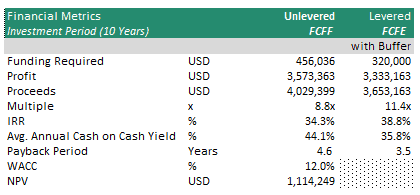
9. Coffee Farmers Financing Sources
9.1 Equity
You must be willing to invest a significant amount in establishing your coffee farm. The initial investment needed is land acquisition, land clearing/preparation, planting, seedlings, labor, and maintenance.
9.2 Banks
Before asking for bank loans, make sure to prepare a financial plan to show your proposed project’s feasibility. The bank will be willing to invest if they can see that you have a clear plan on managing and making your coffee farm profitable. A financial model that also shows the funding required and debt repayments can help you present to the bank how much you need to start or expand your coffee plantation. Collateral is necessary to borrow funds from banks. Nevertheless, banks are the most accessible and faster loan source. Some local banks for thetop coffee farming countries are listed below.
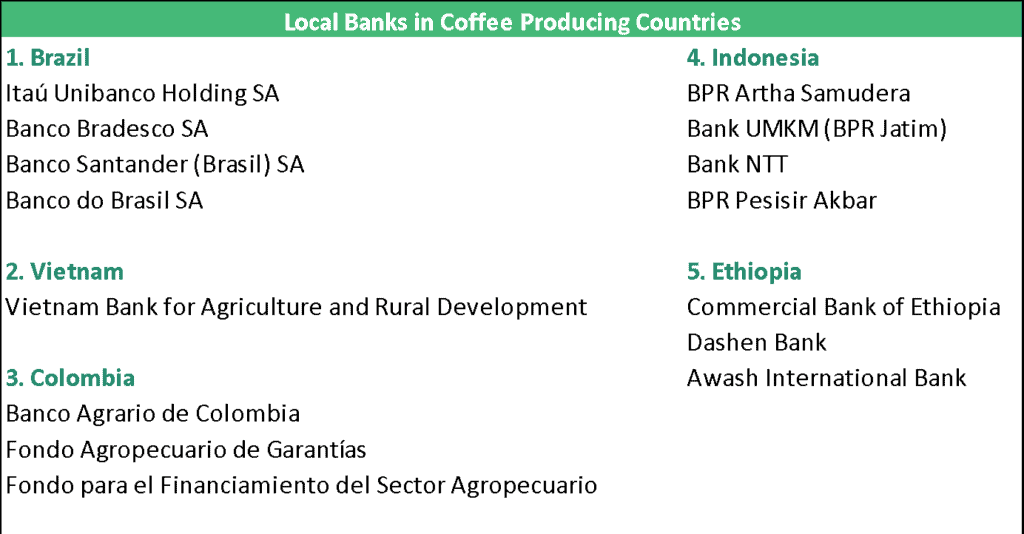
9.3 Other Financing Sources
There are available financing and grants for farmers who can’t access banks or want other funding options. These are the private lending companies, and grants mostly coming from developed countries to developing coffee-producing countries, and financing from multi-national companies.
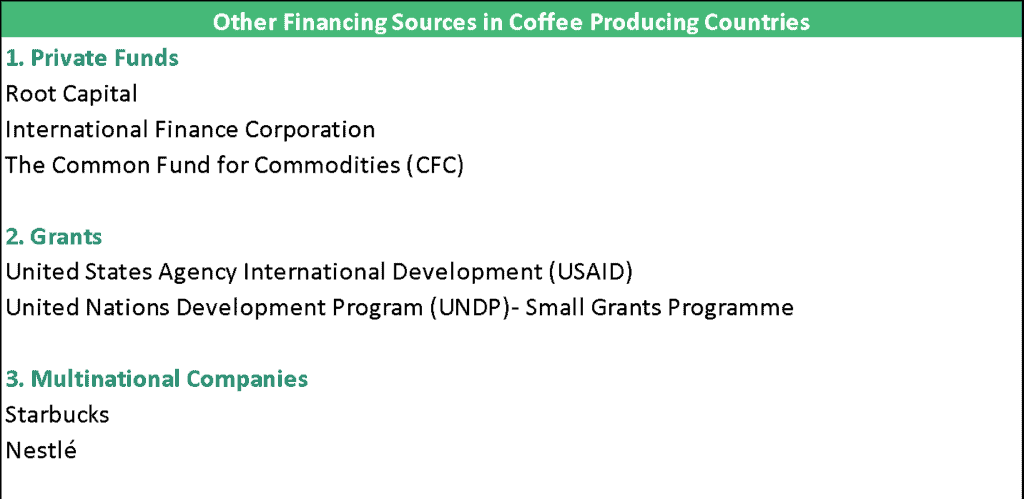
10. Financial Model Templates for Coffee Farming
You can use financial model templates for coffee farming from eFinancialModels with Comprehensive and Simple templates prepared. A Comprehensive Financial Model presents monthly projections for ten years, while the Simple Financial Template is a 10-year projection with a tailored format for debt schedule when sourcing funds.
Additional financial model templates are also available on the Agriculture financial model template page.
For more information and inquiries, you can visit our website or contact us. You can also watch our YouTube video presentation explaining the concepts for your coffee farming financial plan.
To get this article as an eBook, download it here:
Article as eBook


